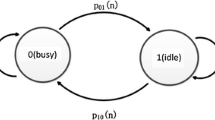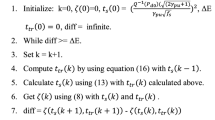Abstract
In cognitive radio (CR) networks, the channel sensing order is crucial for the CR users to find an available channel as fast as possible. In this paper, besides the primary user activities, the statistics of Signal-to-Noise Ratio for each channel are explored using pilot signals. Based on the fluctuating nature of heterogeneous channels as well as the QoS requirements of various applications, two channel sensing order methods are proposed. For real-time applications, a minimum delay-based channel sensing order is proposed to find an idle channel which meets the sustainable rate constraint as fast as possible. For best-effort applications, a maximum capacity-based channel sensing order is proposed to maximize the transmission rates for the CR users, and two different stopping rules are considered. One is that a CR user should stop and transmit at the first free channel, while for the other one, a q-stage look-ahead stopping problem is considered. The simulation results show that the opportunity-discovery delay is reduced for real-time applications. For best-effort applications, the second stopping method is better than the first one when the time cost of the pilot signal is small.
Similar content being viewed by others
References
Akyildiz I. F., Vuran M. C., Mohanty S. (2008) A survey on spectrum management in cognitive radio networks. IEEE Communications Magazine 46(4): 40–48
Lai L., El Gamal H., Jiang H., Poor H. V. (2011) Cognitive medium access: Exploration, exploitation, and competition. IEEE Transactions on Mobile Computing 10(2): 239–253
Cheng H. (2011) Simple channel sensing order in cognitive radio networks. Selected Areas in Communications 29(4): 676–688
Shin K. G. (2008) Efficient discovery of spectrum opportunities with MAC-layer sensing in cognitive radio networks. IEEE Transactions on Mobile Computing 7(5): 533–545
Kim, H., & Shin, K. G. (2008). Fast discovery of spectrum opportunities in cognitive radio networks. In 2008 3rd IEEE symposium on new frontiers in dynamic spectrum access networks (pp. 1–12).
Yuan G., Grammenos R., Yang Y. (2010) Performance analysis of selective opportunistic spectrum access with traffic prediction. IEEE Transactions on Vehicular Technology 59(4): 1949–1959
Han H., Wang J., Wu Q. (2010) Optimal wideband spectrum sensing order based on decision-making tree in cognitive radio. Wireless Communications and Signal Processing 2009: 1–5
Jiang, H. (2009). Optimal selection of channel sensing order in cognitive radio. In IEEE Transactions on Wireless Communications.
Chang, N. B., & Liu, M. (2007). Optimal channel probing and transmission scheduling for opportunistic spectrum access. In Proceedings of the 13th annual ACM international conference on Mobile computing and networking–MobiCom ’07 (p. 27).
Zhao Q., Geirhofer S., Tong L., Sadler B. M. (2008) Opportunistic spectrum access via periodic channel sensing. IEEE Transactions on Signal Processing 56(2): 785–796
Ma, R. -T., Hsu, Y. -P., & Feng, K. -T. (2009). A POMDP-based spectrum handoff protocol for partially observable cognitive radio networks. In 2009 IEEE wireless communications and networking conference (pp. 1–6).
Vizireanu, D. N., & Halunga, S. V. (2012). Simple, fast and accurate eight points amplitude estimation method of sinusoidal signals for DSP based instrumentation. Journal of Instrumentation, 7(04), P04001–P04001.
Vizireanu D. N. (2012) A fast, simple and accurate time-varying frequency estimation method for single-phase electric power systems. Measurement 45(5): 1331–1333
Fan R., Jiang H. (2009) Channel sensing-order setting in cognitive radio networks: A two-user case. IEEE Transactions on Vehicular Technology 58(9): 4997–5008
Lee W., Akyildiz I. F. (2008) Optimal spectrum sensing framework for cognitive radio networks. IEEE Transactions on Wireless Communications 7(10): 3845–3857
Yang L., Cao L., Zheng H. (2008) Proactive channel access in dynamic spectrum networks. Physical Communication 1(2): 103–111
Perez-Romero, J., Sallent, O., Agusti, R., & Giupponi, L. (2007). A Novel on-demand cognitive pilot channel enabling dynamic spectrum allocation. In 2007 2nd IEEE international symposium on new frontiers in dynamic spectrum access networks (pp. 46–54).
Feng Z., Zhang Q., Tian F., Tan L., Zhang P. (2010) Novel research on cognitive pilot channel in cognitive wireless network. Wireless Personal Communications 62(2): 455–478
How K. C., Ma M., Qin Y. (2011) A MAC-layer QoS provisioning protocol for cognitive radio networks. Wireless Personal Communications 65(1): 203–222
Huang, H., Zhang, Z., Cheng, P., & Qiu, P. (2009). Opportunistic spectrum access in cognitive radio system employing cooperative spectrum sensing. In VTC spring 2009—IEEE 69th vehicular technology conference (pp. 1–5).
Akyildiz I., Lee W., Vuran M., Mohanty S. (2006) NeXt generation/dynamic spectrum access/cognitive radio wireless networks: A survey. Computer Networks 50(13): 2127–2159
Cordeiro C., Challapali K., Birru D., Shankar S. N. (2006) IEEE 802.22: An introduction to the first wireless standard based on cognitive radios. Journal of Communications 1(1): 38–47
Lee W. -Y., Akyldiz I. F. (2011) A spectrum decision framework for cognitive radio networks. IEEE Transactions on Mobile Computing 10(2): 161–174
Author information
Authors and Affiliations
Corresponding author
Rights and permissions
About this article
Cite this article
Huang, J., Zhou, H., Chen, Y. et al. Optimal Channel Sensing Order for Various Applications in Cognitive Radio Networks. Wireless Pers Commun 71, 1721–1740 (2013). https://doi.org/10.1007/s11277-012-0906-x
Published:
Issue Date:
DOI: https://doi.org/10.1007/s11277-012-0906-x




